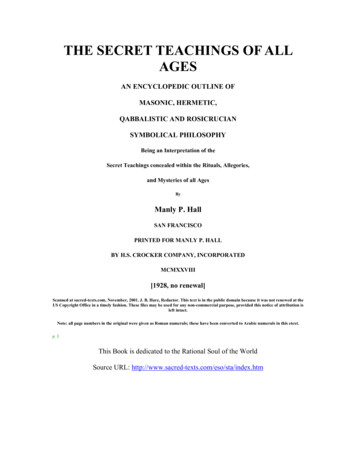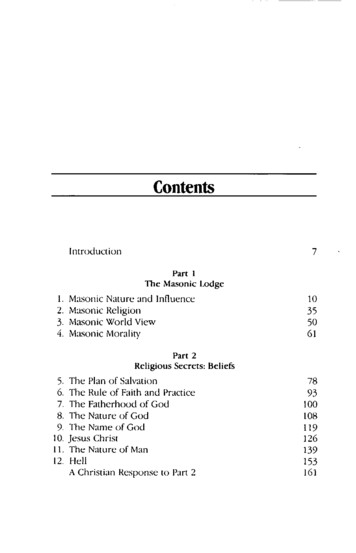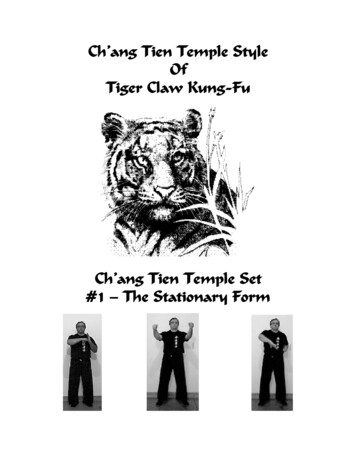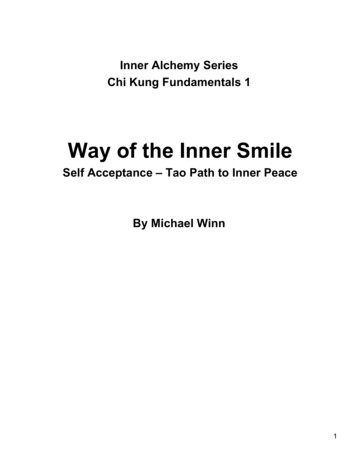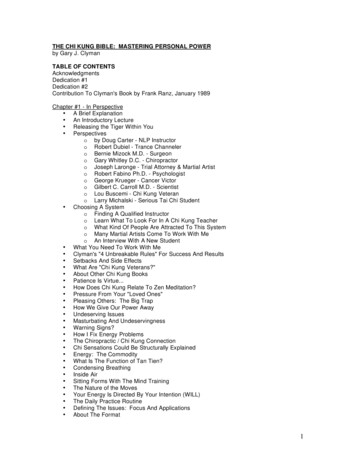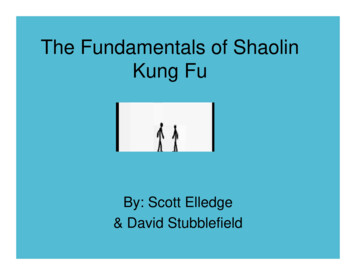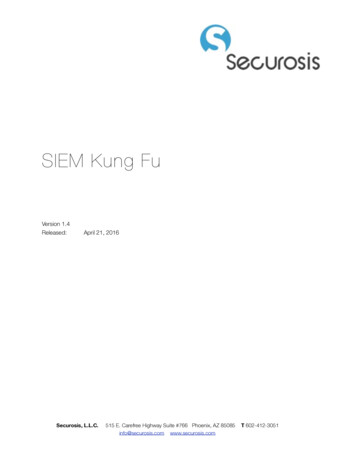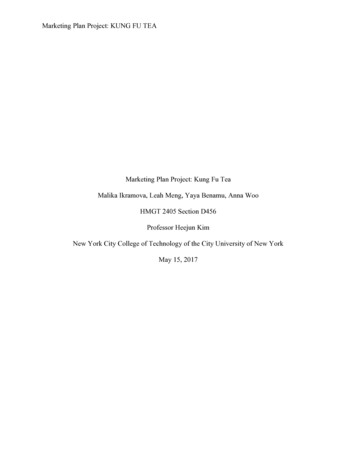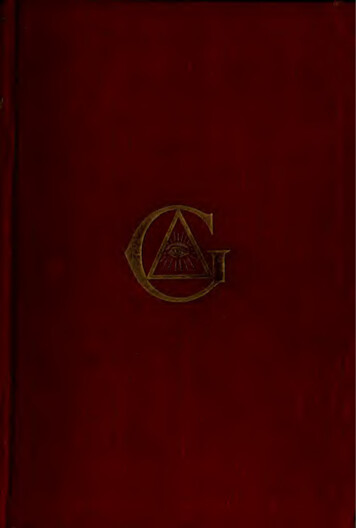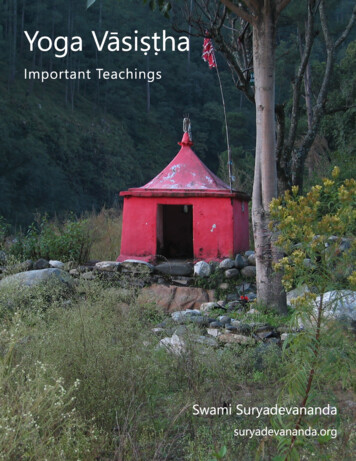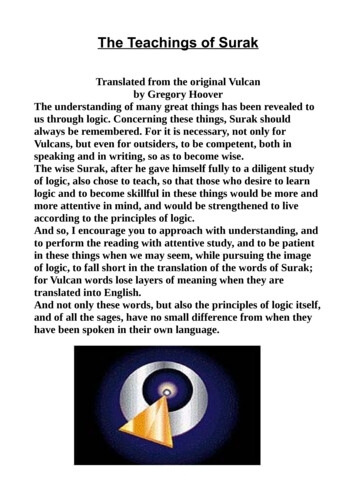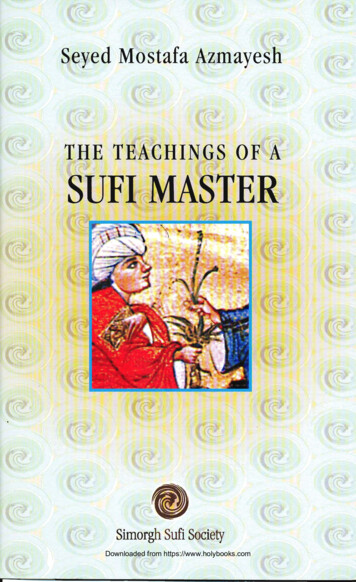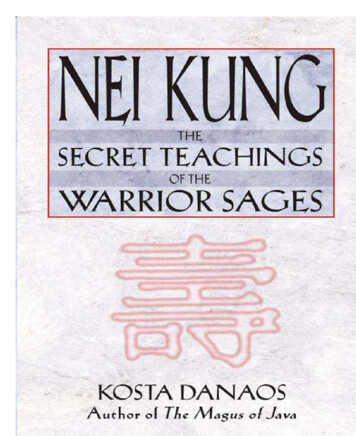
Transcription
ACKNOWLEDGMENTSI have had the great fortune in this life of being acceptedas John Chang’s apprentice; my efforts to reach thepublic would not have been possible without his consentand encouragement, and it is to him first and foremostthat I must offer my gratitude. I have been blessed withpeople around me who make my path easier to walk,people who hold me steady when I am in danger ofslipping; this book could not have been written withoutthem. To Elias then, without whose support I wouldnever have journeyed so far into the forgotten side ofourselves. To my students and friends at theWenwukuan, many of whom train much more fiercelythan I ever did; you are, each and every one of you, mybrothers and sisters. To Handoko, without whoseassistance neither The Magus of Java nor Nei Kungwould have been possible. To Karolos, for all thesojourns into humanity’s past and the training we dotogether. And finally to Doris, for putting up with me; itcan’t be easy.CONTENTSAcknowledgmentsIntroduction
Chapter 1: Whispers from the PastChapter 2: MetalChapter 3: MicrocosmChapter 4: SpheresChapter 5: The ThunderboltChapter 6: The Warrior EliteChapter 7: PracticeChapter 8: Wenwukuan StoriesConclusionAppendix 1Appendix 2FootnotesAbout the AuthorAbout Inner TraditionsBooks of Related InterestCopyrightINTRODUCTION
There was once a man in China who liked pictures ofdragons. His clothing and his furniture weretherefore accordingly adorned with dragons. Thisdeep affection for their kind was brought to theattention of the Dragon Lord, who one day sent a realdragon to stand outside the man’s window. It is saidthat he promptly died of fright.Yamamoto Tsunetomo1Each of us lives within the confines of our individualreality. This is our choice; we choose to live in such amanner—with the same beliefs of what is real and what isnot as those often dictated to us from birth. Our societycertainly exerts its influence on our behavior, limiting uswithin its predefined systems and within what it perceivesas common sense. Few people are above this. Ourdreams, however, unrestricted by society’s whims andthe binding chains of narrow logic, often soar abovethese confines. We are then exposed to a differentreality, a place where our innermost hopes and desiresare free to express themselves. You see, we have nothingto lose in this new reality. We tell ourselves, “This is justa dream,” and so are free to live as we truly wish.Protected by our private curtains, free from retribution,we dance out our hopes and aspirations, our innermostfears, within our own minds.As a species, we have not always been so submissive.Primitive man was free to explore his world without theconstraints of a rigorously mechanized society to bindhim; he was free to investigate his earth and discern itsshape without preconception. The realm of dreams andthat of the physical were not so far apart; indeed, theshaman, whose job it was to sojourn into the world of
shaman, whose job it was to sojourn into the world ofdreams and twilight, was an integral component ofsociety. One could say that primitive man used hisdreams as an extension of his five better-known senses.Even today, however, the dreams that dance in oursubconscious mind can take shape in the physical world.Progressing as we do through life, we frequently come tofind that the myths and legends of humanity, the storiesour grandmothers told us, are indeed true. And thenwhat? What do you do when a myth presents itself toyou in the flesh? What do you do when a quaint folkbelief, accepted by your ancestors but denied by ourmodern day, knocks at your door? Do you run away?Do you have a heart attack and collapse?I myself do not. Never having used drugs and beinghealthy in all respects, I do not doubt the testimony of myown senses. I do not run away. I do not hide. Nor am Iafraid, for fear of ridicule, to share with others therevelations I unearth. Part of me is a warrior, you see,and loves a good fight—and as anyone who has givenone knows, an academic presentation often turns into agood fight, played with the mind rather than with the fists,and against multiple adversaries at that.Welcome then, once again, to my world. It is a placewhere there are no limits, where whatever once hadshape and form in the history of humanity has found ahome. My world revolves around that forgotten part ofour soul—that forgotten side of ourselves—that has beentrod upon for reasons of control and domination, Ibelieve, for the last four millennia of our development.What exactly is the forgotten side of ourselves? It is thatportion of our heritage that is scoffed at as superstition ormake-believe today. It is that part of our innermost beingthat quietly acknowledges aspects of reality we know tobe true, yet hesitates to openly acknowledge them for
fear of ridicule. It is our inner connection to thosearchetypal aspects of existence that primitive or less“modern” cultures continue to embrace, but that weWesterners look upon as quaint, or backward, or evena s (shudder) “neat.”2 It is that side of ourselves thatexists with open access to all that may defy our world’sideas of logic and reason.In 1994 I saw a documentary on television thatchanged my life forever. Called Ring of Fire: East ofKrakatoa, and produced by the brothers Lorne andLawrence Blair in 1988, the film described theirexperiences in the Indonesian archipelago. Central to thedocumentary was a brief sequence with a shy andsomewhat reclusive Chinese-Javanese acupuncturist whoperformed wonderful things, unbelievable things, for thecamera. He demonstrated his full mastery of thephenomenon of ch’i, or bioenergy, by generating an“electrical” current within his body, which he used first toheal one filmmaker of an eye infection, and then to set anewspaper on fire with his hand.Ring of Fire caused thousands to seek out thisindividual in pursuit of instruction; I was one of thesuccessful ones. In the book The Magus of Java, Idescribed my initial encounter with this master, whosetrue identity I have hidden behind the pseudonym JohnChang (though John really is his name, and so is Chang,after a fashion).3 After many trials and tribulations, hefinally accepted me as his student, and I have since beenprivileged enough to witness phenomena that mostpeople can only dream of. In my years of study with JohnChang, I have experienced pyrogenesis, telekinesis,levitation, telepathy, and things even more exotic. I havespoken with spirits and can testify to their reality. Equallyimportant, I have learned my own teacher’s story, andhave been given permission to publish it. John Chang is a
have been given permission to publish it. John Chang is adirect heir to the lineage of the sixth-century B.C.E. sageMo Tzu, who was Confucius’s greatest rival. Hisdiscipline, called the Mo-Pai, was, until now, little knownin the West.The method through which these incredible abilities arearrived at is called, in Chinese, nei kung, or “innerpower.” It is the equivalent of the Hindu-Buddhistpractice of kundalini yoga, though nei kung involves amartial art and martial practice. Central to the discipline isthe transformation of sexual energy into pureunadulterated power, a force that the practitioner can useat will. The “cauldron” in which this formidable elixir isbrewed is called the dantien (elixir field) in Chinese, andis a bioenergetic nexus located four fingers below ournavel.This second book of mine, in many ways part two ofThe Magus of Java, is not so much about my master,though you will find him weaving himself in and out ofthese pages. Rather, this book is about how his teachingopened my mind and senses and enabled me to perceivethe forgotten side of ourselves. It is by far a morescholarly—and more practical—book than the first one.This is a study guide written for those who were excitedenough by The Magus of Java to pursue furtherinstruction (though I am hoping it will stand on its own asa literary effort) and for those who, regardless of theirfamiliarity with The Magus of Java, wish to learn moreabout nei kung.As I have grown in my knowledge of the Mo-Paitradition, I have discovered that teachings similar to thoseof the Mo-Pai once had a home all around the world; Ihave found evidence of nei kung techniques andreferences to yin and yang energy in almost every ancientculture examined by modern archaeology. It would seemthat these teachings endured in China as fossilized
that these teachings endured in China as fossilizedversions of what was once universal in distribution. Myambition, then, is that they once again find a home inevery country, in every city, in every small village aroundthe globe. I hope to begin with you, the reader; I hope toconvince you, through these pages, to undertake aregular meditative discipline, a regimen whose scope youmay choose at will and tailor to your own personality andaspirations. For it is meditation, in the end, that is the keythat opens the door to the forgotten side of ourselves.I fear we have become unbearably arrogant, you see.Confident as gods in the technological progress we havemade, we scoff at the men and women who were ourancestors. Oh, we admire the Pyramids, the Parthenon,the Great Wall of China. We marvel at the cave drawingsand sculptured bison in the Paleolithic caves of France.We delight in achievements and say, “I wonder how theymanaged that with the technology of their time.” Inessence, we are patronizing them; we consider ourselvessuperior. We deny the full spectrum of what theythemselves believed in. We do not seek to understandthem, these people who were our forefathers; we do notseek to discover why they made the choices they did,what they had seen, what knowledge they possessed thatwas different from our own. It is from our ownstandpoint that we try to reach them, ever judgmental.We deny their world, and try to refashion and study itbased on our own. What nonsense!People are ever practical, especially under conditionswhere survival is an issue, and life in earlier times wassomething one had to struggle for on an almost dailybasis. Ancient peoples, then, cultivated belief becausethey saw that there was pragmatic gain in doing so. Sincehaving been accepted as John Chang’s student, itdawned on me that every myth and legend of humanityprobably has a basis somewhere in fact. For example,
probably has a basis somewhere in fact. For example,for centuries scholars thought that Homer’s Troy was amyth, a story concocted by a blind poet—until a Germanmerchant with more pathos than scientific knowledgestumbled onto her ruins through sheer persistence. JohnChang’s paranormal abilities are real; thousands ofpeople throughout the world can step forward and testifyto that fact. How many other myths and legends are true,hidden in the leaves, silent and waiting for a dedicatedseeker to find?I cannot speak for all of them, though I would like tobelieve that there are yeti and four-hundred-year-oldyogis living in the Himalayan mountains, as I have beentold by Tibetan monks. I personally believe in all mannerof spirits, ghosts, and goblins—yes, sometimes it is ournightmares that take shape as well. But meeting suchbeings is not easy or common; the odds are one in tenthousand or more. Usually, our imagination gets carriedaway, influenced as it is by cinema and literature, and webelieve that something extraordinary is happening when infact our subconscious mind is tricking us.Ultimately, we believe in the fantastic because wewant to believe, because we have a need to believe; theforgotten side of ourselves is ever awake within us,calling to us from fields of dreams. Because ourconsumer-oriented society has made life mundane andstripped the magic from our existence, we desperatelydesire an alternative. Social precepts, for the present,however, dictate that we must ignore these whispers ofour past, that we must continue to forget that part ofourselves. In truth, it would be just as easy for anindividual to saw off an arm or a leg caught in a trap. Thispart of ourselves is written into our DNA; we cannotwalk away from it. In the end, ignoring our innermostvoice leads to desperation, and it is this desperation that
proves to be our undoing, for once desperate, we are nolonger pragmatic in our pursuits. Not being practical isdangerous—knowledge accumulated over millenniabecomes trivialized and people wind up living in fairytales.In truth, finding our forgotten side is not easy and oftenrequires the fortitude of a warrior. It can be frightening—compound this natural phobia with the added factor of amultitude of frauds and hucksters preying on the innocentand you will understand that you must tread very, verycarefully. In the Orient, where masters secretly coexistedwith Western-style development until this pastgeneration, things were much easier to discern: Whilethere were many frauds, true masters were known byreputation and were widely respected. The regularlyaccepted practice of challenge-matches saw to this—frauds were afraid to raise their ugly heads for dread ofbeing challenged by a true master. Today, duels beingrigorously frowned upon by the legal system, this is nolonger the case, and even in the East, prospectivestudents must be ever wary of clever swindlers. Theforgotten side of ourselves is, in short, dangerous turf,and requires a very special type of individual to traverse;this person must be willing first and foremost to face himor herself—and most people shy away from just that.I cannot speak for every myth, for every circumstancethat each of us may have encountered; I can only speakfor myself. In fact, each of us, in the end, speaks only forourselves. This book, then, is my personal journey, myindividual sojourn into the forgotten side. Please enjoy it.In some places the text may seem complex and somepieces may seem to hang separately from others, but Iencourage you to stick with it—I have two reasons forpresenting this book in its chosen format. The first is thatI w
The Magus of Java, is not so much about my master, though you will find him weaving himself in and out of these pages. Rather, this book is about how his teaching opened my mind and senses and enabled me to perceive the forgotten side of ourselves. It is by far a more scholarly—and more practical—book than the first one. This is a study guide written for those who were excited enough by .
